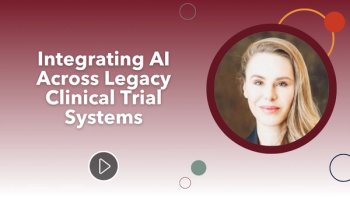
Applied Clinical Trials Supplements
- Supplements-03-02-2006
- Volume 0
- Issue 0
Integrating the Clinical Enterprise
Leveraging technology is key to fulfilling the promise of automation and streamlining clinical trials.
Finding ways to streamline the clinical trial process, i.e., lower costs and speed promising new treatments to market—all while ensuring patient and consumer safety—is a top priority of pharmaceutical manufacturers, the FDA, and third- party technology developers.
Photography: Comstock, EyeWire Illustration: Paul A. Belci
Automating these processes with technology has been viewed as the way to make clinical trials less time consuming, more cost effective, and more efficient. The fact is that many trials fail; and the cost of such failures, in terms of time and money invested, is staggering. The rate of new drug approvals has been steadily declining. Fewer and fewer new treatments are reaching the people who need them; it takes longer and longer to complete a clinical trial, and costs have been rising significantly. According to CDISC, EDC solutions captured 13% of total clinical trials initiated in 2004. Sponsors responding to the CDISC survey also indicated that they expect only 60% to 70% of all clinical trials to be appropriate for technology usage.1
The reasons are varied and complex. They can range from the current legal and political climate, market forces, and global economic issues to technology shortcomings and simple human nature. Many of these issues are beyond the control of any single organization or political entity. One issue that is controllable is how to make the best use of your clinical trial technology.
Simplifying, streamlining, and integrating the technology used in the clinical trial process will help make it less costly and time consuming, thus removing a major obstacle to new research incentives. Improving how technology is used and opening up communication across technology platforms will also enhance the process, creating greater efficiencies and fewer errors.
The FDA has responded to the problem of slowed development with its Critical Path Initiative (CPI). By encouraging cooperation between government, research institutions, and the pharmaceutical industry, the CPI attempts to streamline the clinical trial process by mandating the standardization of clinical practices, standards, and definitions, and by developing new and better trial technologies. In fact, among all of the issues cited by the FDA in its CPI document, technology is rightly identified as the most promising in terms of effecting a rapid and broadly acceptable solution. However, mandating a technology solution is a small part of the process. Many technology tools have been produced over the past few years to automate the clinical trial process, but they do not all speak to each other.
Figure 1. Integrating the Enterprise.
How did we get here?
Before computerization, the tasks of collecting, organizing, recording, and analyzing clinical trial data were handled manually. The process was slow, tedious, and prone to error.
The promised benefits of automation appeared here and there, in small isolated pockets, but never broadly enough to be felt across the entire industry.
Due to the sheer magnitude of diversity and complexity in the clinical trial industry, wide use of these new technologies is still pending. At present, many pharmaceutical, research, and clinical trial organizations still find themselves using methods from the last century—paper-based manual systems —to perform tasks that would be more efficiently completed using technology.
Another part of the problem is that across the industry, the technology infrastructure is hopelessly diverse, incompatible, and/or simply out of date. This is a natural result of organizational infrastructure lagging behind the rapid pace of scientific and technological development.
In spite of the complexity and diversity of the process and the industry, there is a way to integrate the clinical enterprise, helping organizations to make the best use of their technology and get return on their investment.
The promise of widespread integration
By integrating the clinical enterprise you can make use of the many systems designed to handle each particular aspect of the clinical trial process. Ideally, the same developer has created these systems and they all work together seamlessly, share data, and enable faster clinical trial processing. In reality, it does not work that way.
In many organizations, different parts of the trial process are handled by different departments or by different organizations entirely, each with its own way of doing things and its own software applications. Whether these applications were developed in-house, purchased from a software provider, or outsourced to a third- party developer, they are different, and more often than not they are incompatible. The task of integrating the many applications used within a single organization is enormous, requiring human, technical, and financial resources better spent on the organization's core competency—the management of clinical trials. It seems easier to continue to let them run separately, solving the problem of incompatibility by manually collecting data at various points in the process, manually re-entering it in each system as the trial evolves through its phases, and manually recollecting it at the end of the trial for analysis.
The solution...in theory
Centralizing an entire clinical trial operation under a single management system is a daunting task. Review the many and diverse interest groups that must be served: the sponsor, clinical teams, site coordinators and monitors, the data manager, investigators, regulatory representatives, and the statistician. Each of these groups is served by systems particular to its own needs. Some operate separate networks with multiple operating systems (Windows, UNIX, Linux) and different databases (DB2, MS-SQL, Oracle, PostgreSQL). And all run many other proprietary, off-the-shelf business software programs.
Consider the sheer magnitude and diversity of both the data itself and the kinds of data being shared, stored, and retrieved. Sponsors and outsourcing companies need ways to track their clinical trials in great detail. Enrollment, trial costs, patient details, milestones and events, the collection status of case report forms, investigator payments, protocol violations, drug deliveries, and expiration dates are but a few of the data categories involved.
Consider also the very different kinds of functions represented by the myriad of enterprise users and the various types of programs that serve them. First, the clinical trial management system (CTMS), electronic data capture (EDC) systems that collect information, clinical data management systems (CDMS), interactive voice response systems (IVRS) that allow test subject data to be submitted by phone and manage clinical supplies, imaging systems that allow investigators to collect and see X-rays, safety systems, CAT Scans, and other graphic evidence of treatment efficacy. Add to these countless other proprietary and commercial systems.
The various types of programs in the clinical enterprise have different frequency of use expectancies. Typically, CTMS, safety systems, and CDMS will be used across all studies to manage the sponsor's clinical trials, while EDC and IVRS may be used more subjectively, on a trial-by-trial basis.
There is a way to integrate all of these disparate systems into a centralized enterprise.
Integrating the puzzle
The primary requirement of an integrated enterprise-wide technology system is that all the users utilizing the many incompatible programs are able to share, review, sort, and analyze clinical trial data.
In order to integrate your clinical environment, you must evaluate how each application is used in your enterprise. This includes frequency of use, to determine batch or transactional integration requirements. You must evaluate the data sets that are to be interfaced between the applications and define the points of data entry, such as patient data entered into an IVRS or EDC. This eliminates duplicate data entry in multiple applications, and eliminates the potential introduction of human error by minimizing the points of human data entry.
Use standards when integrating your clinical environment. Standards such as the CDISC (Clinical Data Interchange Standards Consortium) ODM (operational data model) provide a well-defined description of certain parts of your clinical enterprise data. CDISC ODM includes CRF data, lab data, and events. Clinical trial operational data is not yet sanctioned by CDISC. (There are standards in development that advocate the extension of the CDISC ODM to include the operational data.) Using standards of integration allows vendor applications to be swapped in and out of the enterprise, either on a trial-by-trial basis or replaced as needed. It also enables broad service partners, i.e., CROs who perform a service associated with an application, such as clinical operational management services associated with a CTMS or data management ser-vices associated with a CDMS. Using standards reduces risks of integration, by reusing tested elements; creates an open, accessible system that provides a stable foundation for future integrations; and allows enterprise components to exchange information efficiently.
Most importantly, to integrate your clinical environment, you must evaluate your business processes. The flow of data must support the clinical process flow. For example, you can set up your sites and visit schedule in a CTMS, passing information to an IVRS, effectively automatically configuring your IVRS. Patients will be enrolled and randomized in IVRS, and that patient information and status can be sent to an EDC application. The EDC, with its study-specific eCRFs, can collect clinical data and events. This information can then be passed back to the CTMS, which can provide status of all elements to the study managers.
By integrating your enterprise, you can achieve higher quality, more accurate data, and streamlined processes with minimized human data entry points. This will enable sponsors to focus on their core competencies—delivering drugs, devices, and treatments to the marketplace quickly.
Are such programs available now?
Yes. A few pharmaceutical and clinical organizations have been employing this approach by developing proprietary interfaces to integrate all or parts of their clinical trial process management. This is helping them to realize the full potential of their technology investments and is improving the clinical trials process through better decisions based on actual data, less errors, and faster results. Additionally, a number of independent technology developers have been working on interface solutions for some time. One approach has been to develop advanced, Web-enabled integration modules as part of a commercial CTMS application. This provides a standard framework for the technology and allows companies to customize the software to their own needs through their choice of modules or the inclusion of pre-existing technology. Additionally, commercial integration offerings are being expanded to embrace the CDISC standards.
Integration enables a seamless connection between systems, giving the clinical development team access to the data they need to make earlier, more informed trial management decisions.
Kate Trainor is senior director, Integrated Services Group, with Perceptive Informatics, Inc., 200 West Street, Waltham, MA 02451, e-mail:
References
1. Tufts Center for the Study of Drug Development, Tufts University, "New Drivers of E-Clinical Technology Adoption," R&D Management Reports.
Articles in this issue
over 19 years ago
Using eLearning to Improve EDC Trainingover 19 years ago
Integrating EHR with EDC: When Two Worlds CollideNewsletter
Stay current in clinical research with Applied Clinical Trials, providing expert insights, regulatory updates, and practical strategies for successful clinical trial design and execution.






.png)



.png)



.png)
.png)
